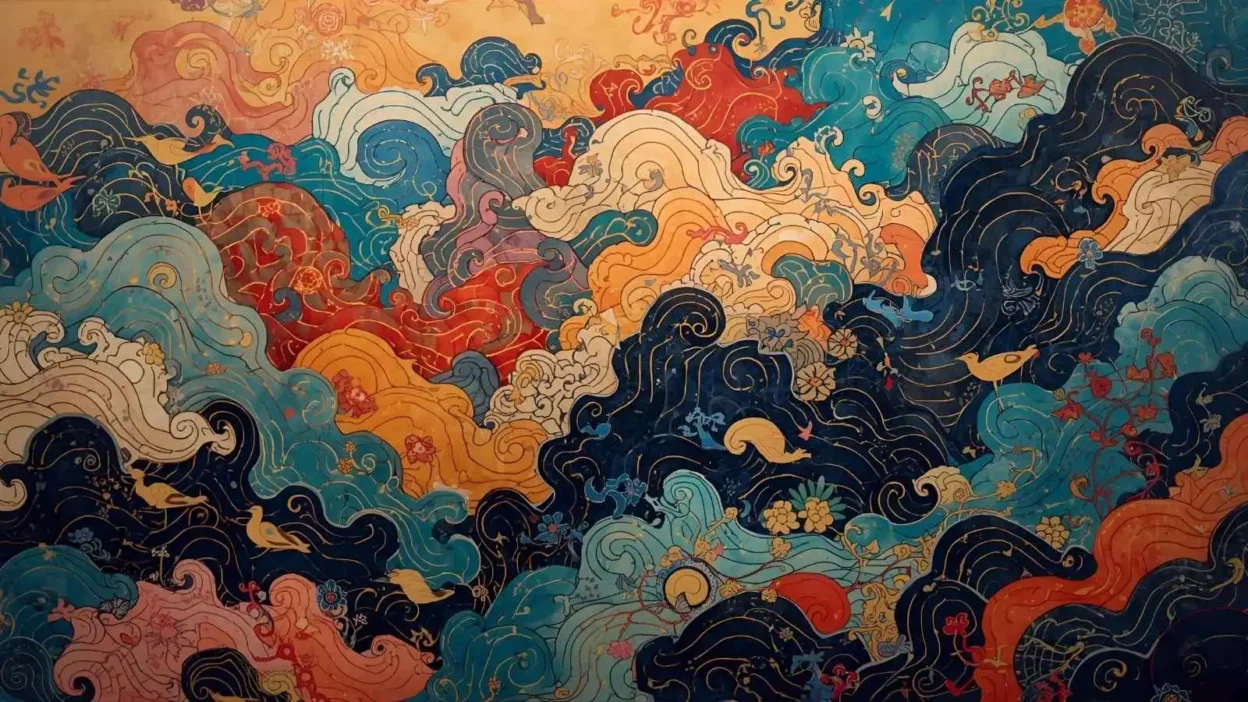On a misty morning in Kyoto, I wandered through a quiet temple garden, lost in thought.
My heart was heavy, searching for meaning during a difficult time in my life. As I sat beneath a cherry tree, an old woman approached me.
She was dressed in a flowing indigo kimono with hints of orange and gold. She smiled gently and said, “Colors speak when we learn to listen.”
That one sentence changed my view forever. In Japan, colors are more than visual beauty—they carry emotional weight, spiritual wisdom, and centuries of meaning. Each shade holds stories, traditions, and energetic messages that can help guide our personal journey. Today, we’ll explore Japanese color symbolism, uncovering the deeper messages behind each hue and how these ancient meanings can still comfort and empower us in modern life.
Japanese Color Symbolism Chart
To begin, here’s a simplified Japanese color symbolism chart that reveals the spiritual and emotional meanings of common colors:
| Color | Japanese Name | Symbolism |
| White | Shiro | Purity, mourning, new beginnings |
| Red | Aka | Life force, protection, celebration |
| Blue | Ao | Calm, loyalty, spiritual awareness |
| Yellow | Ki | Courage, sunshine, nobility |
| Black | Kuro | Mystery, strength, endings |
| Orange | Daidaiiro | Happiness, love, tradition |
| Green | Midori | Nature, youth, peace |
| Purple | Murasaki | Spirituality, luxury, wisdom |
These colors are more than aesthetic choices. They are used in rituals, clothing, festivals, and even in the design of shrines and temples. Their deep spiritual roots offer a way to interpret our emotions and life events more clearly.
Traditional Japanese Color Symbolism
Traditional Japanese color symbolism traces back to ancient times, especially the Heian period (794-1185), when colors were carefully chosen for court clothing and religious use. These colors were tied to the five elements (wood, fire, earth, metal, water) and the directions in Buddhist cosmology.
- Red (Aka) was used to ward off evil spirits. Babies often wore red bibs to symbolize protection.
- White (Shiro) represented the sacred. It was worn by monks and used in funerals, representing the purity of the soul moving on.
- Black (Kuro) symbolized experience and maturity but also had ties to death and the unknown.
- Purple (Murasaki) was reserved for nobles and spiritual leaders due to the difficulty of making the dye—it symbolized wisdom and sacred power.
- Green (Midori) was tied to growth, fertility, and the vitality of the natural world.
Even today, Shinto and Buddhist ceremonies in Japan still reflect these color traditions, using specific hues to create spiritual balance and call in divine protection or blessing.
Japanese Color Symbolism in Culture
Color isn’t just spiritual in Japan—it’s woven into daily life, art, and emotional expression. For example:
- In kimono design, color choices reflect the seasons, life events, and emotional states. A bride might wear red for luck and fertility, while a widow may wear white to show sorrow and purity.
- In Japanese gardens, color arrangement supports balance and harmony. Green trees offer calm, red bridges energize the soul, and white stones offer clarity.
- During festivals, colors help express joy and devotion. The bright oranges of lanterns or the reds of shrine gates help people feel spiritually uplifted and connected.
In Japanese culture, color is not random. It’s intentional, meaningful, and used to communicate emotion, energy, and respect—both to others and to the divine.
Japanese Color Symbolism Yellow
Yellow, or Ki, holds deep power in Japanese tradition. Though less flashy than red or blue, it represents:
- Nobility and courage in battle. In samurai times, warriors wore yellow to show valor.
- The warmth of sunlight, tied to happiness and positivity.
- Sacred knowledge, often associated with Buddhist robes and spiritual insight.
In modern symbolism, yellow can help someone feel confident, hopeful, and respected. If you find yourself drawn to yellow, your spirit may be seeking renewal and inner strength.
Japanese Color Symbolism Blue
In Japanese culture, blue (Ao) symbolizes:
- Calmness, like the steady flow of a river or the peacefulness of the sky.
- Trust and sincerity—qualities honored in friendship and spiritual discipline.
- Spiritual protection, especially in Shinto rituals where indigo blue fabric is used to purify spaces.
Blue is a grounding color. It connects you to truth, wisdom, and clarity. Wearing blue or seeing it in dreams may be a spiritual nudge to seek honesty, rest, or emotional healing.
Japanese Color Symbolism Orange
Orange, or Daidaiiro, is a vibrant, joyful color rooted in:
- The bitter orange fruit (daidai), whose name also means “generation after generation”—symbolizing family continuity and ancestral blessings.
- Love, health, and celebration in Shinto festivals.
- A bridge between red’s energy and yellow’s joy—offering a warm, inviting emotional tone.
If orange keeps showing up in your life, your soul may be longing for connection, renewed love, or healing within your lineage.
Real-Life Color Symbolism Scenarios
1. The Indigo Kimono in the Temple
A young woman walks into a Kyoto shrine wearing an indigo kimono. She’s mourning her grandmother and feeling lost. The blue in her garment grounds her, helping her breathe through her grief. An elder whispers, “Your sorrow is sacred. Let it flow like water.” The blue guides her back to peace.
2. A Red Gate in a Storm
A man walks through a torii gate painted bright red during a thunderstorm. Despite the lightning, he feels protected. Red, symbolizing spiritual protection, reminds him to trust the path—even during emotional chaos.
3. The Yellow Crane Gift
A little girl battling illness receives a thousand folded paper cranes from her classmates—each one bright yellow. That color becomes her symbol of hope. It brings courage in her healing journey, a golden light amid the pain.
Frequently Asked Questions (FAQs)
1. Why is color so important in Japanese culture?
Color reflects emotions, spiritual beliefs, and ancient rituals. It’s a nonverbal language that connects the human and the divine.
2. What’s the most spiritually powerful color in Japan?
It depends on context, but red (for protection) and white (for purification) are among the most sacred in rituals.
3. Are colors still used spiritually in modern Japan?
Yes. From temple flags to wedding attire, traditional meanings still guide choices—even in modern fashion or seasonal festivals.
4. What does green symbolize in Japanese spirituality?
Green is peace, fertility, nature, and balance. It’s often used to represent harmony with the Earth and emotional healing.
5. How can I use Japanese color symbolism in my own life?
Use it to set intentions. Wear red for courage, blue for calm, or yellow for strength. Paint or decorate with purpose. Let color guide your emotional and spiritual growth.
Conclusion:
In a world full of noise, color is a quiet teacher. Japanese color symbolism invites us to slow down, reflect, and honor the unseen energies that guide our lives. Whether it’s the bold red of a temple gate or the gentle yellow of a crane, each hue offers a message from the heart of the universe.
As I left that Kyoto temple years ago, I noticed the orange sun breaking through gray clouds. It felt like a sign—an invitation to heal, grow, and keep listening.
May you also find comfort in these colors. May they guide you gently, speak to your soul, and remind you that even in silence… you are deeply understood.




